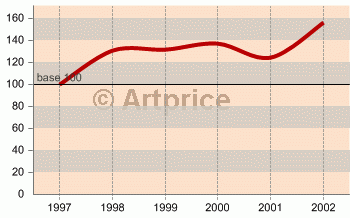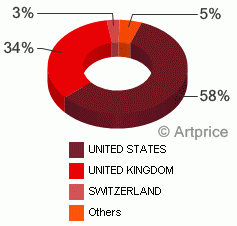Hans Arp (1887-1966)
[26.05.2003]
Auctioneers Calmels-Cohen are to break up the collection assembled by Hans Arp’s brother, François Arp. The Dada artist’s price index has gained 56% since 1997 and a new record for his work was set at the recent Breton sale.
Jean Harp (or Hans Arp) was born in 1887 in Alsace, and it was there that he first studied painting. Following a brief spell in Paris in 1904, he moved on to the Académie des Arts in Weimar between 1905 and 1907 and then the Académie Julian, Paris, in 1908. He was involved in the first Moderner Bund (Modern League) exhibition in 1911, where works by Swiss painters hung alongside contributions from Picasso and Matisse. After meeting Kandinsky in 1912, he took part in the “Blauer Reiter” (Blue Rider) exhibition in Munich. He was a co-founder of the dada movement in Zurich in 1916, and from that time on collage became one of his favourite media. He also began painting wood reliefs. Arp had a show at the Galérie Surréaliste in 1927. He created his first sculptures in the 1930s and from then on blended the three roles of sculptor, painter and bilingual (German-French) poet until the end of his life. His international renown was sealed when he won the sculpture prize at the Venice Biennale in 1954 and had an exhibition at New York’s Museum of Modern Art in 1958.
Artworks at auctions
In 2002, 54 Hans ARP works were sold at auction. Of these 52% were prints that sold for average hammer prices of around EUR600. Sculptures (30% of lots sold) accounted for almost 70% of total sales. Alongside his painted wood reliefs from the 1920s, his white marble sculptures from the late 1950s remain the most sought-after works. The record for an Arp work was recently achieved by Femme, a major relief from 1927, pre-empted by the French state at the Calmels-Cohen April 14 sale for EUR2.5 million. The most sought after of his works on paper are the biomorphic collages and “papiers déchirés”, and the top price ever paid for an Arp was the EUR86,616 fetched by Poupée Nombril (1925), a 60×80 cm collage, at Sotheby’s London in June 2000.
The market places
Although 92% of total turnover took place in the US or UK in 1999-2002, France has a good opportunity to claw back market share in 2003 thanks to the auctioneer Calmels-Cohen. It has already sold Arp works to the value of EUR3.4 million in its sales of 14-15 April and is offering another 26 from the collection of his brother François, on 12 June.
Buy or sell
The timing is perfect. Arp’s overall price index has risen by 56% since 1997 driven largely by higher prices for his paper works and paintings. After a significant fall in 2001 due to anexcess of bronzes of which collectors are not very fond, sculptures prices are now at the same level as six years ago. But in the same period, the price of his drawings has practically tripled, although almost half of lots offered failed to find a home in 2002. As with the art market as a whole, as prices soar it is only quality that sells. Prints were going for almost twice as much in 2002 as they did in 1998: even collectors with the shallowest pockets can hope to get a foot on the Arp bandwagon. To take one example, Composition I, a lithograph from 1958 of which 75 copies were made, went for EUR409 in 2000, EUR511 in 2001 and EUR600 in 2002.
Hans Arp Artprice Indexall media categories, base January 1997 = 100, currency: EUR  Hans Arp Lots sold at auctions
Hans Arp Lots sold at auctions  Hans Arp Auction sales turnover 1999-2002 / weight by country
Hans Arp Auction sales turnover 1999-2002 / weight by country  © Artprice
© Artprice




 0
0
